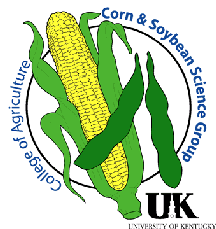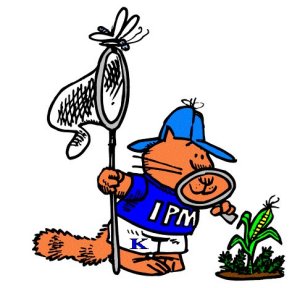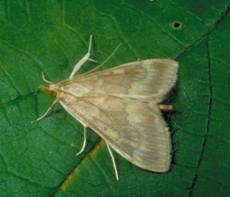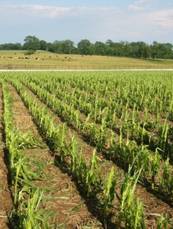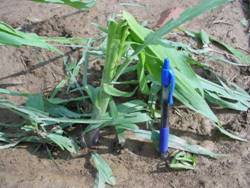Corn & Soybean News
July 2009, Volume 9, Issue 5
Corn and Soy Newsletter Home
Grain Crops Extension Home
Cooperating Departments: Agricultural Economics, Biosystems and Agricultural Engineering,
Entomology, Plant Pathology , and Plant and Soil Sciences
Editor: Chad Lee
In this issue
1. European Corn Borer Emerging
2. Foliar Fungicides for Corn in 2009
3. Corn Hail and Wind Damage
4. Critical Stages for Soybean Yield
5. Simulating Soybean Hail Damage
6. Watching Corn Grow
7. Paperless, but Still in Print
printer-friendly pdf (Note: this html site is also printer-friendly)
1. European Corn Borer Emerging
Ric Bessin, Extension Entomologist,
Entomology, University of Kentucky
The moths of the first generation European corn borer are beginning to emerge in western Kentucky with the rest of the state to follow shortly. Late planted corn is more vulnerable to losses from first generation European corn borer. Growers will need to watch the late planted crop carefully. Fortunately, much of the late planted corn has Bt for corn borer control.
But farms using Bt corn will also need to have a non-Bt refuge that is at least 20% the size of the entire corn field. The non-Bt refuge is designed to slow the development of resistance by the pests to the Bt corn. Growers will need to pay attention European and southwestern corn borers in these non-Bt refuges. Moths that will be laying eggs for the second generation of these pests are active now and growers will need to monitor fields in the coming weeks.
Because of the wet spring and early summer, corn planting was delayed in many corn fields. Late planted corn is late harvested corn. This increases potential losses to corn borers late in the season. Corn planted after May 5th in western Kentucky or May 15th in central Kentucky is considered late planted. Growers that planted their non-Bt refuges as a block to one side of the field, or as separate fields may have an opportunity to control these caterpillar pests before they reduce yields in their refuges.
Strong grain prices are impacting how we set economic threshold for insect pests in corn. In the past with lower grain prices, we generally recommended control when 50% of the plants are infested with small European corn borer larvae in the whorl, this year the threshold is closer to 25% infested plants. With Southwestern corn borer, because it is a more destructive pest, we recommend treatment when 20% of the plants are infested with small larvae in the whorl. As always with both of these borers, controls are ineffective once the larvae have begun to tunnel into the stalk.
Another option for some growers is to target the fields infested with Southwestern corn borer for the earliest possible harvest. This corn may need to be dried after harvest. This can reduce the amount of stalk girdling by this pest.
|
|
Figure 1. European corn borer moth. |
Table 1. Current European Corn Borer Degree Day Development as Listed for Selected Sites from the UK Ag Weather Center
(6/23) |
2nd Gen |
(6/23) |
2nd Gen |
||||
Current |
moths |
larvae |
|
Current |
moths |
larvae |
|
Location |
DD Total |
1660DD |
1860DD |
Location |
DD Total |
1660DD |
1860DD |
|
|
|
|
|
|
|
|
Bardstown |
1478 |
6/28 |
7/6 |
Jackson |
1311 |
7/5 |
7/13 |
Berea |
1276 |
7/6 |
7/14 |
Lexington |
1239 |
7/8 |
7/16 |
Bowling Green |
1516 |
6/26 |
7/5 |
London |
1325 |
7/4 |
7/12 |
Buckhorn Lake |
1318 |
7/5 |
7/13 |
Louisville |
1313 |
7/5 |
7/13 |
Campbellsville |
1321 |
7/4 |
7/12 |
Mayfield |
1322 |
7/4 |
7/12 |
Covington |
1195 |
7/10 |
7/18 |
Paducah |
1554 |
6/25 |
7/3 |
Cumberland Gap |
1328 |
7/4 |
7/12 |
Princeton |
1639 |
6/29 |
|
Dix Dam |
1230 |
7/8 |
7/16 |
Quicksand |
1315 |
7/5 |
7/13 |
Glasgow |
1624 |
6/22 |
6/30 |
Somerset |
1378 |
7/2 |
7/10 |
Grayson |
1259 |
7/7 |
7/15 |
Spindletop |
1280 |
7/6 |
7/14 |
Hardinsburg |
1354 |
7/3 |
7/11 |
Williamstown |
1187 |
7/10 |
7/18 |
Henderson |
1355 |
7/3 |
7/10 |
|
|
|
|
2. Foliar Fungicide Considerations for Corn in 2009
2. Fungicide Considerations for Corn in 2009
Paul Vincelli, Extension Plant Pathologist
Plant Pathology, University of Kentucky
Interest continues in the possible use of fungicides for field corn in Kentucky during this growing season. As far as disease-control products, the strobilurins Table 1) continue to be the strongest products. They generally provide very good to excellent control of gray leaf spot and northern leaf blight, our most common foliar disease threats in Kentucky. They also are good against southern rust and common rust. However, southern rust typically comes in too late to threaten the large majority of Kentucky corn crops, and corn hybrids in Kentucky typically have high enough levels of resistance to common rust that it does not affect yield. Thus, fungicide applications are very commonly unnecessary against the rust diseases in Kentucky corn. Of course, a long list of other diseases can attack corn: anthracnose, various stalk rot diseases, ear rots, kernel rots, common smut, Stewart's wilt, the virus complex, brown spot, northern leaf spot, Holcus spot, etc. With rare exceptions, these fungicides will do little to nothing against these other diseases. In Kentucky, by far the most important use of foliar fungicides is to control gray leaf spot and, where it occurs, northern leaf blight.
Based on university research, I think there are many corn fields that will produce optimal yields without fungicides. However, I realize that sales pressure makes that kind of thinking sound so "twentieth century". Some fungicide sales reps are telling growers that they can find gray leaf spot and rust in every field they scout. It's not surprising to find these diseases in corn fields, but that doesn't mean they will develop into serious threats. In fact, common rust is commonly widespread in corn at this time of year, but hybrids typically have enough resistance to keep that disease a mere curiosity. Gray leaf spot can develop into a serious threat, but how much gray leaf spot develops depends on lots of things.
The risk factors for gray leaf spot are listed in Figure 1. The more of these that are in place in a field, the higher the risk of disease and, therefore, the more likely the producer is to see a positive economic response from a fungicide. If a grower is considering making a fungicide application, do so to the fields with the highest risk of disease.
Table 1. Fungicides commonly being used in corn production throughout the United States.
|
Fungicide |
Active ingredient(s) |
Chemical class(es) |
Headline |
pyraclostrobin |
Strobilurin |
Quadris |
azoxystrobin |
Strobilurin |
Quilt |
azoxystrobin + propiconazole |
Strobilurin + Triazole |
Stratego |
trifloxystrobin + propiconazole |
Strobilurin + Triazole |
As indicated in Figure 1, gray leaf spot activity at tasseling is a risk factor. But how much gray leaf spot is enough to trigger concern? Is one lesion in a 20-acre field enough? Well, no, it's not. The fungicide guidelines being offered by several universities in the Midwest are as follows:
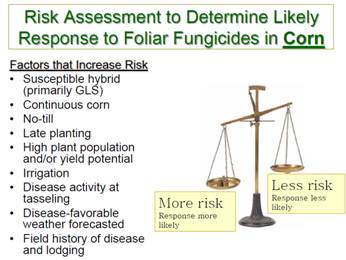
Figure 1. Risk factors for gray leaf spot of corn. For the most part, the same risk factors apply to northern leaf blight, as well.
Some producers are asking if an insecticide should be included with the fungicide application on corn, instead of an adjuvant. UK entomologists respond that an insecticide should be used only if there is a specific threat from insect pests. Routinely including an insecticide in the corn fungicide application is costly, wasteful, and environmentally damaging if there is no specific insect threat in that field.
One of the corn fungicides (Headline) is being marketed as a plant growth promoter in addition to a fungicide. Claims for this product include increased growth efficiency and improved stress tolerance. While these things are apparently possible in some cases, university research indicates that they occur unpredictably and not often enough to use the product purely as a growth promoter.
Bottom line: The best advice I can give is to consider carefully whether a fungicide is needed in your corn fields, and to base the decision to treat on the risk of gray leaf spot, as well as on Northern leaf blight if it occurs. Many times fungicides aren’t necessary. If you chose to spray a foliar fungicide always leave several untreated strips. Compare yields with a yield monitor to see how much benefit, if any, the fungicide gave you.
3. Corn Hail and Wind Damage
Chad Lee, Extension Agronomist
Plant and Soil Sciences, University of Kentucky
Isolated hail storms and strong winds have hit areas of Kentucky in several events. The extent of damage depends on the growth stage, leaf area destroyed and surviving stand.
Hail Damage
Corn approaching the V6 growth stage (six visible collars) is usually highly tolerant of hail damage. As the corn plant gets closer to tasseling, it becomes more susceptible to hail damage. Corn is most susceptible to hail damage just prior to tasseling through early milk. Once corn passes through the early milk stage, it becomes more tolerant to hail damage.
Leaf removal by hail is the primary factor in hurting yields. Any green leaf material, even that which is shredded, will still function. Table 1 is a general guideline for defoliation and expected yield losses. The 8-leaf stage as determined by a hail adjuster is usually equal to a V6 leaf stage (six collars visible). Table 1 is adapted from the National Crop Insurance Association's "Corn Loss Instructions" (Rev. 1984) and the entire table can be found in a Nebraska Extension publication (Vorst, 1986).
Corn plants damaged by hail early in the season usually recover from tied whorls and bruised stalks. The corn will usually grow through these tied whorls within three or four weeks (Mangen and Thomison, 2000). Stalk bruising had little impact on lodging. If bruising occurs directly on the growing point of the corn plant, then the corn plant may not survive. Silking will be delayed on severely damaged corn plants. Corn from V5 through V7 that received 100% leaf loss had a 1 to 1.5 week delay in silking compared with plants that received 80 to 90% leaf loss.
Hail can also wound stalks and will kill entire plants. Stand reductions can reduce yield. For most of Kentucky, stands ranging from 22,000 to 30,000 plants per acre are ideal, depending on soil type. Stands below 22,000 plants per acre will cause yield reductions. Replanting corn is not an option at this point.
Table 1. Estimated percent yield loss occurring from defoliation (assumes no stand reduction). |
||||||||||
Growth Stage* |
Percent Leaf Area Destroyed |
|||||||||
10 |
20 |
30 |
40 |
50 |
60 |
70 |
80 |
90 |
100 |
|
Estimated Yield Loss (%) |
||||||||||
7-leaf |
0 |
0 |
0 |
1 |
2 |
4 |
5 |
6 |
8 |
9 |
8-leaf |
0 |
0 |
0 |
1 |
3 |
5 |
6 |
7 |
9 |
11 |
9-leaf |
0 |
0 |
1 |
2 |
4 |
6 |
7 |
9 |
11 |
13 |
10-leaf |
0 |
0 |
2 |
4 |
6 |
8 |
9 |
11 |
14 |
16 |
11-leaf |
0 |
1 |
2 |
5 |
7 |
9 |
11 |
14 |
18 |
22 |
12-leaf |
0 |
1 |
3 |
5 |
9 |
11 |
15 |
18 |
23 |
28 |
13-leaf |
0 |
1 |
3 |
6 |
10 |
13 |
17 |
22 |
28 |
34 |
*Hail adjusters’ method for staging corn. The 8-leaf stage is usually similar to V6 corn, where 6 collars are visible. |
||||||||||
|
. Photo 2. (right) Corn hail damage in younger plants in Fleming County, Kentucky, 2007. (photo submitted by Jeff Smith) |
Wind Damage
Corn plants knocked over by the wind can recover if the stalks were not broken. Often, these plants will adjust and the stalk will return to vertical. However, a bend in the stalk (gooseneck) near the soil surface is likely. These plants are more prone to lodging again, whether it be from another storm or from the weight of a heavy ear after blacklayer (physiological maturity). Producers should consider harvesting gooseneck corn soon after blacklayer to reduce the chances of lodging.
In some fields corn stalks snapped over from the wind. The breakage is usually below the growing point of the plant, effectively killing that plant. Again, re-planting is not an option.
Salvage Options
The corn forage should be tested for possible toxins, nitrates and feed value. Putting up electric fences and allowing cattle to strip graze the field is probably the best salvage option. The forage will likely be too wet for proper ensiling. Some farmers might try to let the corn wilt in the field (similar to hay) but the current weather patterns are not conducive to wilting and corn does not wilt nearly as well as typical hay crops. If possible, stay with grazing and be sure cattle have access to clean water, shade, etc.
References:
Lee, C.D. J.H. Herbek, G. Lacefield and R. Smith. AGR-79: Producing corn for silage. Kentucky Coop. Ext. Service, Univ. of Kentucky. Lexington. http://www.ca.uky.edu/agc/pubs/agr/agr79/agr79.pdf
Mangen, T. and P. Thomison, 2002. Early season hail damage in corn: effects of stalk bruising and tied whorls. Agronomic Crops Team On-Farm Research Projects 2000. Special Circular 179-01. http://ohioline.osu.edu/sc179/sc179_16.html
Vorst, J. J. 1986. Assessing Hail Damage to Corn, G86-803-A: http://ianrupus.unl.edu/fieldcrops/g803.htm
4. Critical Growth Stages for Maximum Soybean Yield
D.B. Egli, Crop Physiology
Plant and Soil Sciences, University of Kentucky
This year’s soybean crop has been blessed with almost too much rain so far, but unless we are extremely lucky, the rains will stop sometime during the summer. Dry spells in Kentucky don't happen every year (it just seems that way), but when they do they can last for most of the summer, or, more commonly, for just a couple of weeks. The effect of these short dry spells on yield will depend upon how long they are and when they occur during the life cycle of the soybean crop.
The soybean plant goes through three distinct phases of growth between planting and maturity: 1.) vegetative growth, 2.) flowering and pod set, and 3.) seed filling. Vegetative growth in soybean actually continues until the end of flowering and pod set, but for our purposes here, vegetative growth will be the period from planting until the first flower appears (growth stage R1).
Phase One, vegetative growth, is not as sensitive to dry weather as the other phases. During vegetative growth the plant produces the leaves and roots that are going to do the work of producing yield. The leaves use the energy in sunlight to convert carbon dioxide in the air into the simple sugars that serve as the building blocks for all plant and seed tissues, while the roots take up the water and nutrients that the plant needs for growth.
To produce maximum yield, the plants must produce enough leaves to completely cover the ground by initial bloom (growth stage R1). If they don’t, some sunlight will reach the ground and be wasted, reducing the number of pods and seeds, and yield. The ample rains so far this season will probably ensure ground cover by R1. Reaching full ground cover by R1 is easier with narrow rows or full season varieties, but late plantings, especially in wide rows, make it more difficult. Soybeans usually produce more than enough leaves to cover the ground so they can lose some leaves to dry weather and still reach complete ground cover by growth stage R1, making vegetative growth less sensitive than phase two or three.
The critical phase when drought must be avoided is Phase Two, flowering and pod set. During flowering and pod set, the soybean plant determines how many pods and seeds to produce. Dry weather during this phase will reduce pod and seed number and yield. Some of the lost yield can be recovered by producing larger seeds, but this adjustment may not be large enough to get it all back.
Flowering and pod set can continue for up to 40 days in Kentucky. We used to think that this allowed the plant plenty of time to recover from a short dry spell. But, in our field experiments, soybean could not recover from 14 days of stress at the beginning of flowering and pod set even though flowering continued for nearly 20 days after the stress. The pods lost to stress were not recovered and yield was reduced. The good news was that stress periods of less than 10 days during peak pod production had no effect on pod survival or yield.
Drought during Phase Three, seed filling, will hurt yield. This is not surprising since this phase is when yield is actually produced; phases one and two are only the preliminaries to the main event. Water stress during seed filling accelerates normal leaf senescence where leaves turn yellow and fall off the plant, causing early maturity, smaller seeds and lower yield. The early maturity of soybean plants on hill tops where the soil is shallow is a vivid example of water stress hastening maturity.
The 2009 soybean season is off to a late, but amply wet start. Vegetative growth is proceeding well and the leaves and roots are developing the machinery to produce high yield. We need timely rains for the next 60 days to realize this potential. If dry spells occur, they will have the greatest effect on yield during flowering and pod set, and seed filling.
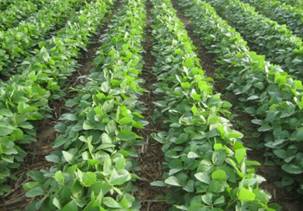 |
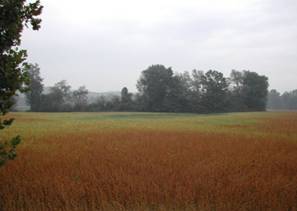 |
Soybean in 30-inch rows at R1 growth stage. The soybeans have not reached full canopy and yield potential has been lost. |
Drought stress during seed filling phase resulted in early senescence of plants in regions of the field |
5. Simulating Soybean Hail Damage
Chad Lee, Extension Agronomist
Plant and Soil Sciences, University of Kentucky
Soybeans damaged by hail usually recover much better than corn. Hail will remove leaves and can break stems reducing the amount of nodes on the plant. Soybeans can compensate for reduced stands and missing leaves by branching and filling in empty spaces in fields. A study was funded by the National Crop Insurance Service to better understand the effect of node removal on yield in Kentucky. This study was conducted in 2008 and is being repeated in 2009. These studies previously were conducted in Iowa and Indiana.
The 2008 results from Kentucky suggest that soybean was less sensitive to node removal at earlier growth stages. Node removal at the V1 growth stage had no significant effect on yield. Complete node removal at the V4 growth stage reduced seed yield, but the other node removal treatments had no effect. Node removals at the R3 growth stage reduced yields.
These results are from one year and we must be careful about drawing too many conclusions at this point. However, the data from the one season in Kentucky is relatively similar to data from Iowa and Indiana (Conley et. al. 2009).
Figure 1. Node removal effect on yield at Lexington, Kentucky, 2008. Node removal of 100% consisted of removing every part of the soybean plant above the cotyledons.
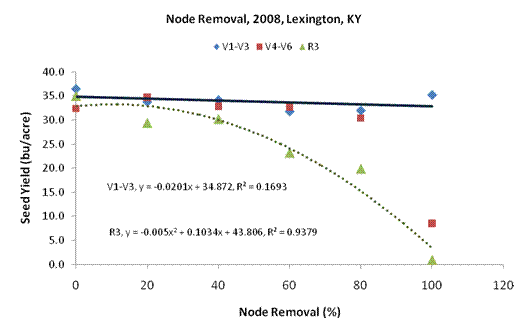
References:
Conley, S.P., P. Pedersen, and E.P. Christmas. 2009. Main-stem node removal effect on soybean yield and composition. Agron. J. 101: 120-123.
6. You Can Almost See Corn Growing
Lloyd Murdock and Dottie Call, Extension Soils Specialist and Wheat Science Coordinator,
Plant and Soil Sciences, University of Kentucky
Once the corn plant becomes established with several leaves and stalk elongation begins (around V6 growth stage) you can almost see the corn growing. Each day brings a noticeable difference if the growing conditions are good. After watching for several years, we decided to measure a single corn plant’s growth through vegetative development. The corn plant was chosen from within a stand of corn that was planted at about 28,000 plants per acre. The stand was planted about April 20, 2008 and had good fertility and moisture conditions during the vegetative growth stage.
The measurements were taken 18 of the 31 days of the trial beginning June 3, so growth stages may not be exactly to the day. Height measurements were made to the lowest point of the whorl.
Table 1. Measured Growth of a Corn Plant in 2008. |
||||
Dates Measured |
Growth Stage* |
Height during Growth Stage** |
Growth Rate |
|
inches |
inches/day |
% of height/day |
||
June 3-9 |
V6 |
12 – 20 |
1.4 |
10 |
June 10-13 |
V7 |
20 - 26 |
1.8 |
7 |
June 13-19 |
V8 |
26 - 43 |
2.4 |
6 |
June 20-22 |
V9 |
43 - 53 |
3.0 |
6 |
June 23-24 |
V10 |
53 - 58 |
3.0 |
6 |
June 25-26 |
V11 |
58 - 67 |
4.5 |
7 |
June 27-28 |
V12 |
67 - 74 |
3.5 |
5 |
June 29-30 |
V13 |
74 - 80 |
3.0 |
4 |
July 1-4 |
VT |
80 - 100 |
5.0 |
5 |
* Each growth stage marks the number of fully emerged leaves, according to "How a Corn Plant Develops," Special Report No. 48, Iowa State University Press.
**Height measured to the lowest point of the corn whorl from V6 through V13 growth stages, and to the lowest point of the last developed leaf at VT growth stage.
The corn plant grew between 1.4 and 5.0 inches per day (Table 1) which is a phenomenal rate. It grew an average of about 10% of its height each day during the V6 stage. No wonder it is so noticeable! The plant grew faster at the later growth stages but the percentage of change in height each day was not as great.
The individual leaves even grew faster than the plant. Individual leaves from V6 through V8 growth stages grew 2.5 to 4 inches per day or 0.10 to 0.15 inches (2.5 to 3.8 mm) per hour. That growth rate is something you can almost see.
This is not a precise scientific study. The measurements were made on one plant for one season. However, we feel it gives a person some idea what they are seeing as they pass by a corn field each day and notice a difference.
7. Going Paperless, Yet Still in Print
The University of Kentucky will no longer be printing the Corn and Soybean Newsletter. However, the Kentucky Corn Growers Association is planning to print and mail hard copies of the newsletter. Please notify us if you would like your name removed from the hard copy mailing list.
printer-friendly pdf (Note: this html site is also printer-friendly)
